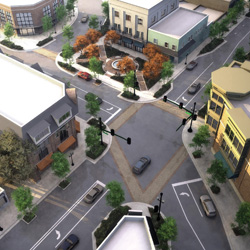“Make no little plans; they have no magic to stir men’s blood…Make big plans…remembering that a noble, logical diagram once recorded will never die, but long after we are gone will be a living thing asserting itself with ever growing consistency.”
—Daniel Hudson Burnham, architect and father of the City Beautiful movement.
The design and development of America’s cities, neighborhoods, public places and open spaces has had its share of peaks and valleys. Population explosions in the latter half of the 1800s and again after World War II meant that homes, factories and businesses needed to be built at break-neck speed. While it did provide much-needed homes and places of employment, it too often led to shapeless neighborhoods, and cities and regions that lacked a sense of place.
The antidote for this in the early 1900s was the City Beautiful movement, pioneered by leading architects, planners, business professionals and everyday concerned citizens. Its focus was to make cities and neighborhoods more attractive and livable by implementing bold plans and designs. The result was the creation of charming neighborhoods and cities that have withstood the test of time. Stroll through a 100-year-old neighborhood and you will notice timeless architecture, walkable streets, neighborhood roundabouts, a diverse mix of land uses, highly visible open spaces, and parks accessible by foot or bicycle.
 Today, including right here in central Illinois, America continues another renaissance in how it plans, designs and markets the neighborhoods, cities, public places, open spaces and regions of tomorrow. And it does this with an eye toward the past. Beginning in the early 1980s, designers, builders and buyers across the nation began to question the way that cities and regions had been developed following World War II. “New Urbanist” communities slowly began to emerge that mimicked the urban planning and design of the City Beautiful movement. These communities contain walkable streets, interconnected street grids, highly visible and accessible public open spaces, preservation of key environmental resources, quality architecture and sustainable development practices.
Today, including right here in central Illinois, America continues another renaissance in how it plans, designs and markets the neighborhoods, cities, public places, open spaces and regions of tomorrow. And it does this with an eye toward the past. Beginning in the early 1980s, designers, builders and buyers across the nation began to question the way that cities and regions had been developed following World War II. “New Urbanist” communities slowly began to emerge that mimicked the urban planning and design of the City Beautiful movement. These communities contain walkable streets, interconnected street grids, highly visible and accessible public open spaces, preservation of key environmental resources, quality architecture and sustainable development practices.
Simultaneous with the New Urbanist movement, other developers and business investors began to develop “conservation” communities and neighborhoods for more rural settings. These projects cluster development on a portion of a site, thus allowing the preservation of key environmental resources (woodlands, wetlands, steep slopes) into interconnected trailways and open space networks. Developers and investors soon realized that selling a view of a woodland was as profitable as selling a view of a golf course.
Is this ‘second wave’ of the City Beautiful movement playing in Peoria and central Illinois? Absolutely. Consider the following that has occurred or is planned to occur in the region:
- The revitalization of downtown Peoria via the Heart of Peoria Plan and the Unified Development Ordinance. New improvements include the development of O’Brien Field, the construction of the Peoria Riverfront Museum and Caterpillar Experience, condominium and loft developments along Water Street, and the ongoing “New Urbanist” streetscape and urban designs for the Warehouse District.
- The revitalization of historic Peoria neighborhoods and business districts, including downtown Peoria Heights, the Randolph-Roanoke Historic District, the Orchard District, the High Wine Historic District, East Bluff United and Old Towne North.
- The New Urbanist-inspired redevelopment of Uptown Normal and the adoption by the Town of Normal of a groundbreaking LEED ordinance. Also, the planned development of a new, walkable downtown based on New Urbanist principles in East Peoria on a former brownfield site.
- Integrated planning and transportation plans and initiatives being spearheaded by the Tri-County Regional Planning Commission and other governing bodies which encourage and promote New Urbanism, conservation design and other sustainable development practices. These initiatives include the creation of bicycle trails that connect urban areas to rural communities, the preservation of key environmental resources, and the design and construction of roundabouts that provide traffic calming and highly visible public green space on prominent streets.
These are just a few of the success stories helping to reinvigorate cities, communities and public places in our region to make them livable, highly marketable and sustainable for generations to come. And while forward-thinking in result, the real key to their success is the embrace of principles that are over a century old. iBi
Jeff Martin, PLA, is a land planner and senior project landscape architect with the Farnsworth Group.


